Complete Solutions to Exercises of chapter SOUND WAVES of Class 11 book with complete answers and questions
| Class 11 | PHYSICS |
| Chapter | SOUND WAVES |
| HC VERMA | Exercises |
| Number Of Questions | 89 |
| Academic Year | 2023-24 |
A steel tube of length 1.00 m is struck at one end. A person with his er close to the othr end hears the sound of the blow twice one travelign through the body of the tube and the other through the air in the tube. Find the time gap between the two hearings. Use the table in the next for speeds of sound in various substances.
View SolutionAt a prayer meeting, the disciples sing JAI-RAM JAI-RAM. The sound amplified by a loudspeaker comes back after reflection from a building at a distance of 80 m from the meeting. What maximum time interval can be kept between one JAI-RAM and the next JAI-RAM so that the echo S eed of does not disturb a listener sitting in the meeting. p sound in air is `320 m s^-1`.
View SolutionA man stands before a large wall at a distance of 50.0 m and claps his hands at regular intervals. Initially, the interval is large. He gradually reduces the interval and fixes it at a value when the echo of a clap merges with the next clap. If he has to clap 10 times during every 3 seconds, find the velocity of sound in air.
View SolutionA person can hear sound waves in the frequency range 20 Hz to 20 kHz. Find the minimum and the maximum wavelengths of sound that is audible to the person. The speed of sound is `360 m s^-1`.
View SolutionFind the minimum and maximum wavelengths of sound in water that is in the audible range (20-20000 Hz) for an average human ear. Speed of sound in water `= 1450 m s^-1`.
View SolutionSound waves from a loudspeaker spread nearly uniformly in all directions if the wavelength of the sound is much larger than the diameter of the loudspeaker. (a) Calculate the frequency for which the wavelength of sound in air is ten times the diameter of the speaker if the diameter is 20 cm. (b) Sound is essentially transmitted in the forward direction if the wavelength is much shorter than the diameter of the speaker. Calculate the frequency at which the wavelength of the sound is one tenth of the diameter of the speaker d- iescribed above. Take the speed of sound to be `340 m s^-1`.
View SolutionUltrasonic waves of frequency 4.5 MHz are used to detect tumour in soft tissues. The speed of sound in tissue is `1.5 km s^-1` and that in air is `340 m s^-1`. Find the wavelength of this ultrasonic wave in air and in tissue.
View SolutionThe equation of a travelling sound wave is `y = 6.0 sin (600 t - 1.8 x) where y is measured in `10^-5m`, t in second and x in metre. (a) Find the ratio of the displacement amplitude of the particles to the wavelength of the wave. (b) Find the ratio of the velocity amplitude of the particles to the wave speed.
View SolutionA sound wave of frequency 100 Hz is travelling in air. The speed of sound in air is `350 ms^-1` (a) By how much is the phase changed at a given point in 2.5 ms ? (b) What is the phase difference at a given instant between two points separated by a distance of 10.0 cm along the direction of propagation ?
View SolutionTwo point sources of sound are kept at a separation of 10 cm. They vibrate in phase to produce waves of wavelength 5.0 cm. What would be the phase difference between the two waves arriving at a point 20 cm from one source (a) on the line joining the sources and (b) on the perpendicular bisector of the line joining the sources ?
View SolutionCalculate the speed of sound in oxygen from the following data. The mass of 22.4 litre of oxygen at STP `(T = 273 K and p = 1.0 xx 10^5N m^-2)` is 32 g, the molar heat capacity of oxygen at constant volume is `C_V= 2.5 R` and that at constant pressure is `C_p = 3.5 R.`
View SolutionThe speed of sound as measured by a student in the laboratory on a winter day is 340 m s when the rdoobmy temperature is `17^@C`. What speed will be measure another student repeating the experiment on a day when the room temperature is `32@C` ?
View SolutionAt what temperature will the speed of sound be double of its value at `0@C ` ?
View SolutionThe absoulte temperature of air in a region linearly increases from `T_1 to T_2` in a space of width d. Find the time taken by a sound wave to go through the region in terms of `T_1, T_2`d and the speed `upsilon` of sound at 273 K. Evalute this time for `T_1 = 280 K, T_2 = 310 K, d 33m and upsilon = 330 m s^(-1)`
View SolutionFind the change in the volume of 1.0 litre kerosene when it is subjected to an extra pressure of `2.0xx 10^5 N m^-2` from the following data. Density of kerosene `= 800 kg m^-3` and speed of sound in kerosene `= 1330 m s^-1`
View SolutionCalculate the bulk modulus of air from the following data about a sound wave of wavelength 35 cm travelling in air. The pressure at a point varies between `(1.0 x 10^5+-14)` Pa and the particles of the air vibrate in simple harmonic motion of amplitude` 5.5 x 10^-6m`.
View SolutionA source of sound operates at 2.0 kHz, 20 W emitting sound uniformly in all direction. The speed of sound in air is `340 m s^(-1)` at a distance of air is `1.2kgm ^(-3)` (a) What is the intensity at a distance of 6.0 m from the source ? (b) What will be the pressure amplitude at this point ? (c ) What will be the displacement amplitude at this point ?
View SolutionThe intensity of sound from a point source is `1.0 xx 10^-8 Wm^-2`, at a distance of 5.0 m from the source. What will be the intensity at a distance of 25 m from the source ?
View SolutionThe sound level at a point 5-0 m away from a point source is 40 dB. What will be the level at a point 50 m away from the source ?
View SolutionIf the intensity of sound is doubled, by how many decibels does the sound level increase ?
View SolutionSound with intensity larger than 120 dB appears painful to a person. A small speaker delivers 2.0 W of audio output. How close can the person get to the speaker without hurting his ears ?
View SolutionIf the sound level in a room is increased from 50 dB to 60 dB, by what factor is the pressure amplitude increased ?
View SolutionThe noise level in a classroom in absence of the teacher is 50 dB when 50 students are present. Assuming that on the average each student outputs same sound energy per second, what will be the noise level if the number of students is increased to 100 ?
View SolutionIn Quincke's experiment the sound detected is changed from a maximum to a minimum when the sliding tube is moved through a distance of 2.50 cm. Find the frequency of sound if the speed of sound in air is `340 m s^-1`.
View SolutionIn Quincke's experiment, the sound intensity has a minimum value I at a particular position. As the sliding tube is pulled out by a distance of 16.5 mm, the intensity increases to a maximum of 9 I. Take the speed of sound in air to be `330 m s^-1. (a) Find the frequency of the sound source. (b) Find the ratio of the amplitudes of the two waves arriving at the detector assuming that it does not change much between the positions of minimum intensity and maximum intensity.
View SolutionTwo audio speakers are kept some distance apart and are driven by the same amplifier system. A person is sitting at a place 6.0 m from one of the speakers and 6.4 m from the other. If the sound signal is continuously varied from 500 Hz to 5000 Hz, what are the frequencies for which there is a destructive interference at the place of the listener? Speed of sound in air` = 320 ms^-1`
View SolutionA source of sound S and a detector D are placed at some distance from one another. A big cardboard is placed near the detector and perpendicular to the line SD as shown in figure. It is gradually moved away and it is found that the intensity changes from a maximum to a minimum as the board is moved through a distance of 20 cm. Find the frequency of the sound emitted. Velocity of sound in air is `336 m s^-1`.

View SolutionA source S and a detector D are placed at a distance d apart. A big cardboard is placed at a distance `sqrt2d` from the source and the detector as shown in figure. The source emits a wave of wavelength `= d/2` which is received by the detector after reflection from the cardboard. It is found to be in phase with the direct wave received from the source. By what minimum distance should the cardboard be shifted away so that the reflected wave becomes out of phase with the direct wave ?
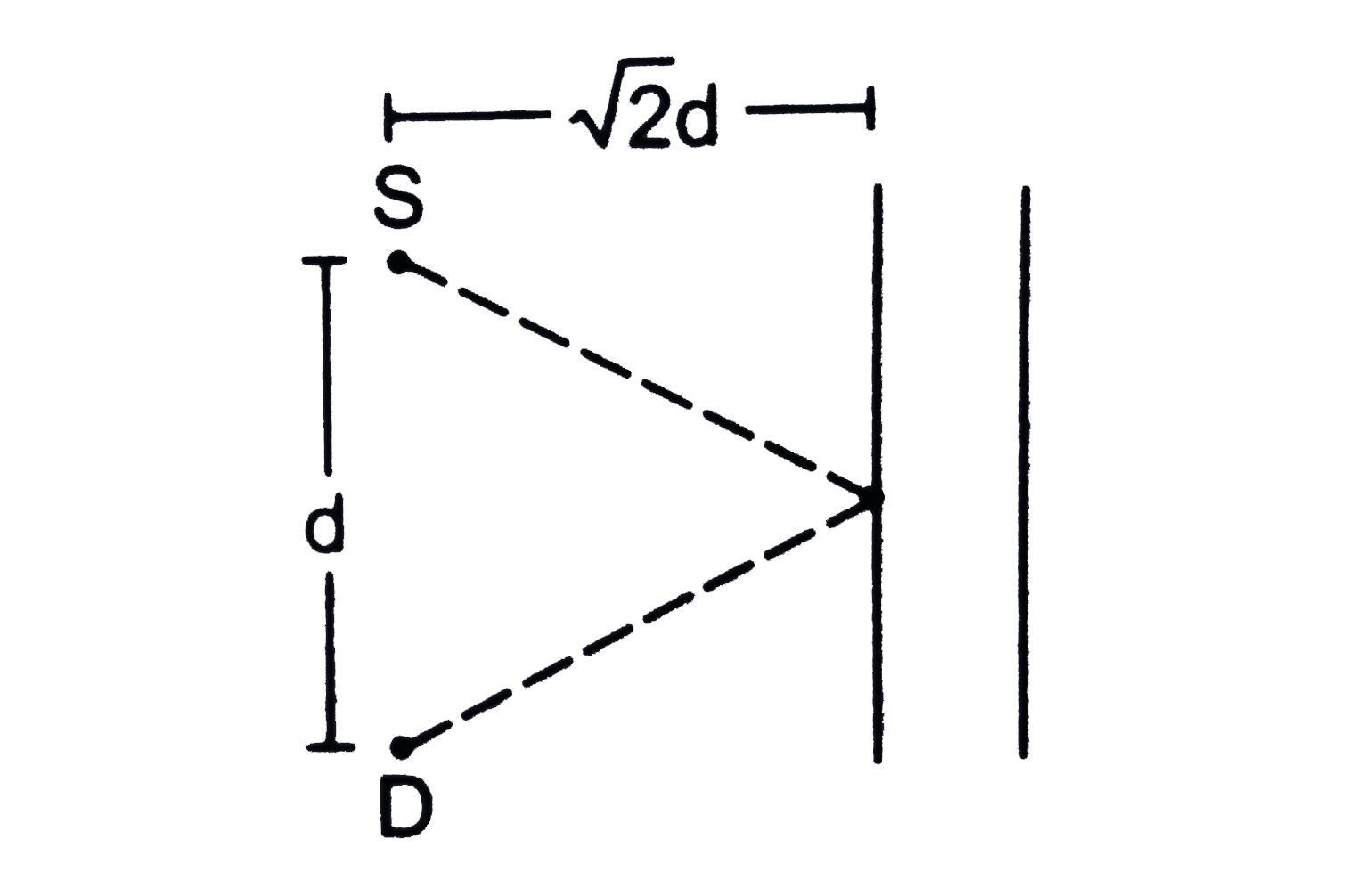
View SolutionTwo stereo speakers are separated by a distance of 2.40 m. A person stands at a distance of 3.20 m directly in front of one of the speakers as shown in figure. Find the frequencies in the audible range (20-2000 Hz) for which the listener will hear a minimum sound intensity. Speed of sound in air `= 320 ms^-1`
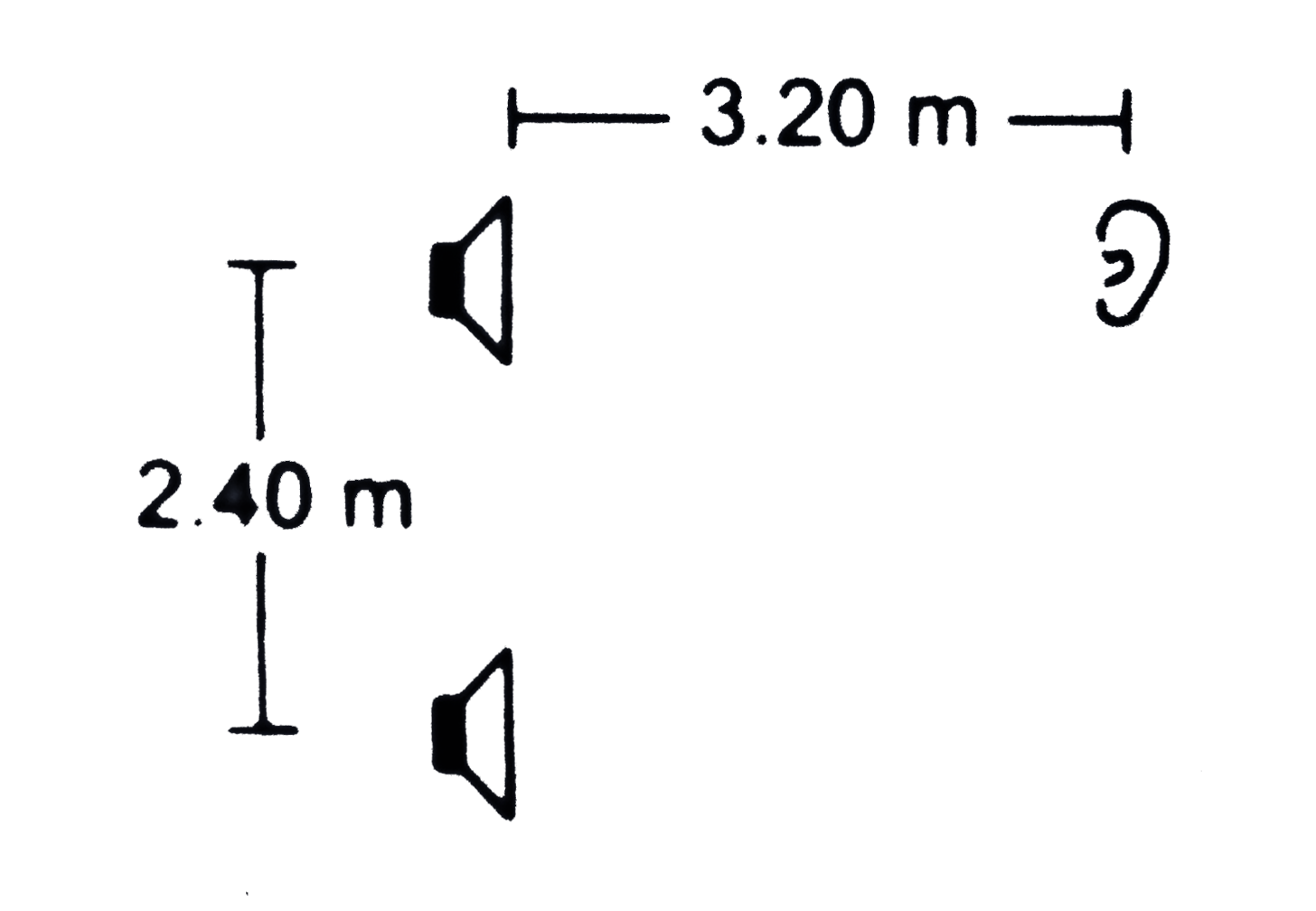
View SolutionTwo sources of sound, ` S_1 and S_2` , emitting waves of equal wavelength 20.0 cm, are placed with a separation of 20.0 cm between them. A detector can be moved on a line parallel to `S_1S_2 and at a distance of 20.0 cm from P it. Initially, the detector is equidistant from the two sources. Assuming that the waves emitted by the sources are in phase, find the minimum distance through wffich the detector should be shifted to detect a minimum of sound.
View SolutionTwo speakers `S_1 and S_2` , driven by the same amplifier, areplaced at `y = 1.0 m and y = -1.0 m`. The speakers vibrate in phase at 600 Hz. A man stands at a point on the X-axis at a very large distance from the origin and starts moving parallel to the Y-axis. The speed of sound in air is` 330 ms^-1` (a) At what angle `theta` will the intensity of sound drop to a minimum for the first time ? (b) At what angle will he hear a maximum of sound intensity for the first time ? (c) If he continues to walk along the line, how many more maxima can he hear ?
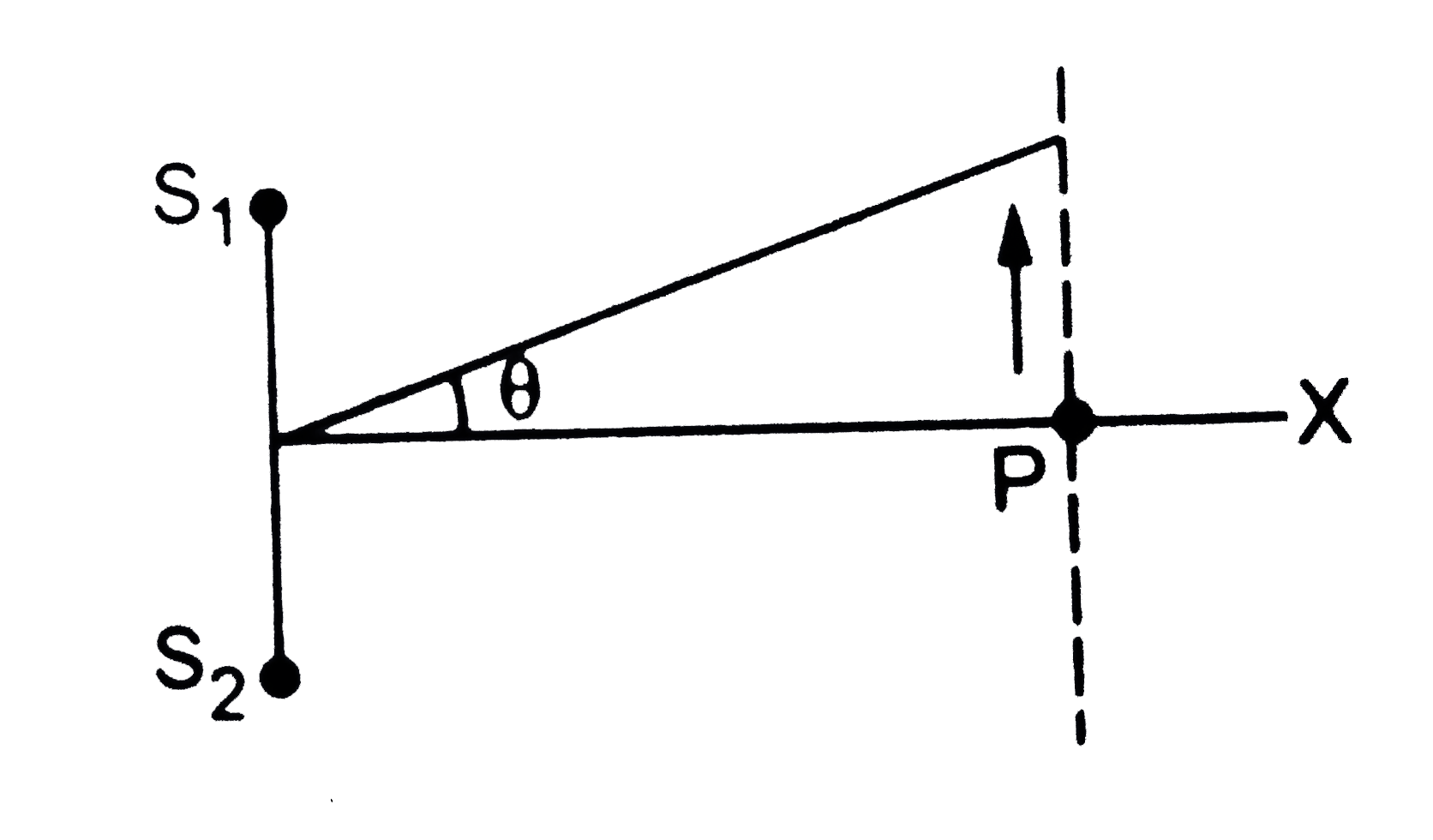
View SolutionThree sources of sound `S_1, S_2 and S_3 of equal intensity are placed in a straight line with `S_1S_2=S_2=S_3`. At a point P. far away from the sources, the wave coming from `S_2 si 120^@` ahead in phase of that from `S_1`. Also, the wave coming from `S_3 is 120^@` ahead of that from `S_2`. What would be the resultant intensity of sound at P?

View SolutionTwo coherent narrow slits emitting sound of wavelength lamda in the same phase are placed parallel to each other at a small separation of `2lamda`. The sound is detected by moving a detector on the screen `sum` at a distance D(gtgtlamda) from the slit `S_1` as shown in figure. Find the distance x such that the intensity at P is equal to the intensity at O.
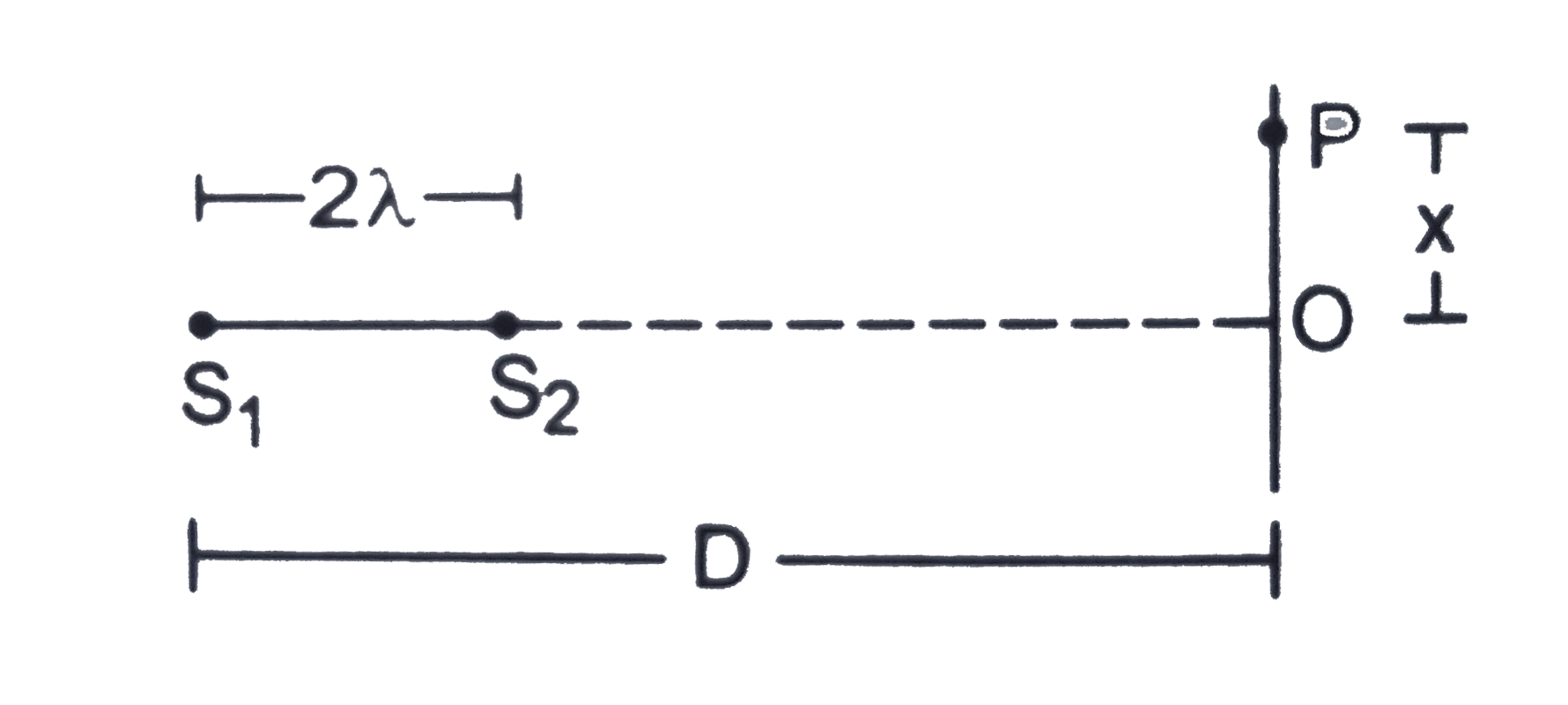
View SolutionFigure shows two coherent sources `S_1 and S_2`which emit sound of wavelength `lamda` in phase. The separation between the sources is `3lamda`. A circular wire at large radius is placed in such a way that `S_1 S_2` lies in its plane and the middle point of `S_1 S_2`, is at the centre of the wire. Find the angular positions 0 on the wire for which constructive interference takes place.
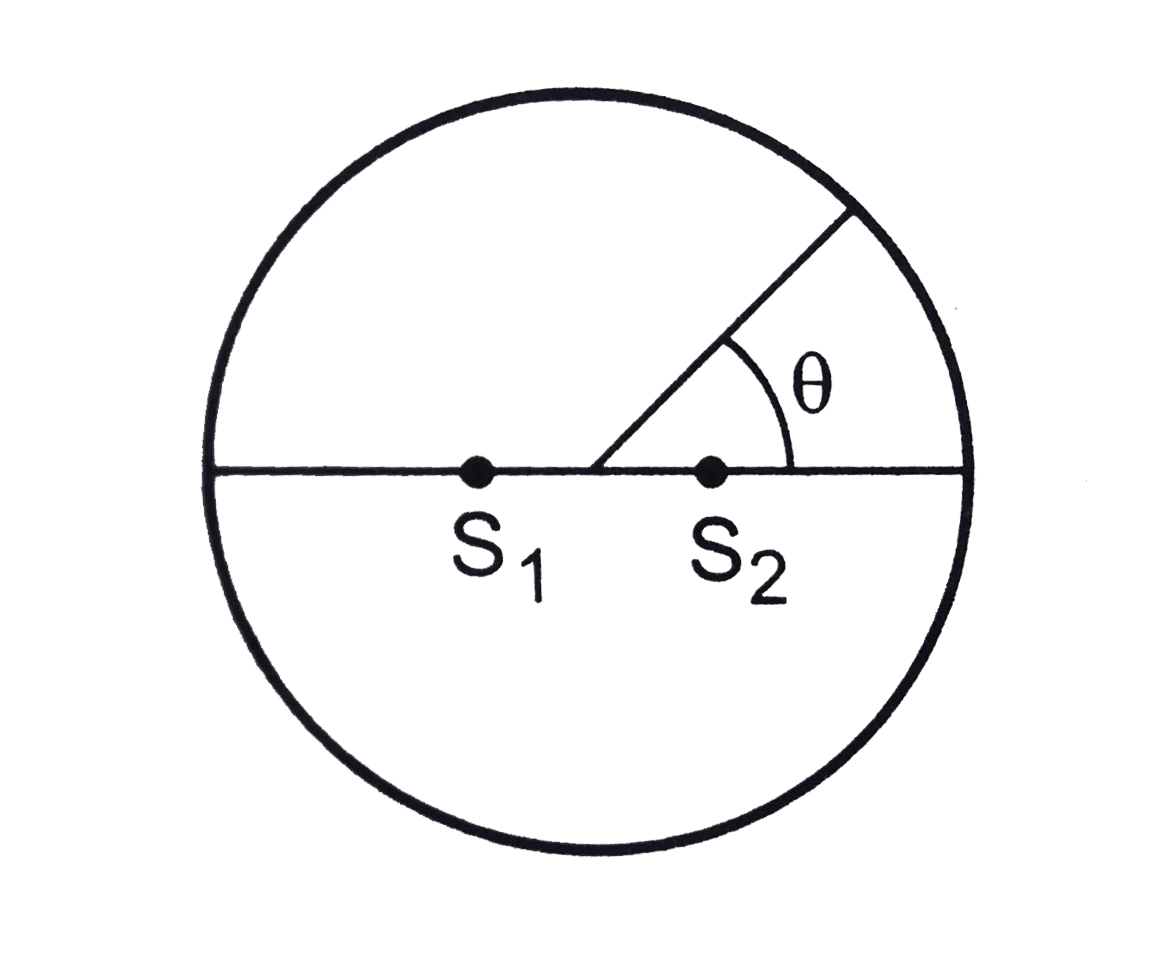
View SolutionTwo sources of sound `S_1 and S_2` vibrate at same frequency and are in phase. The intensity of sound detected at a point P as shown in the figure is `I_0` . (a) If theta equals `45^@`, what will be the intensity of sound detected at this point if one of the sources is switched off ? (b) What will be the answer of the previous part if `theta= 60^@` ?
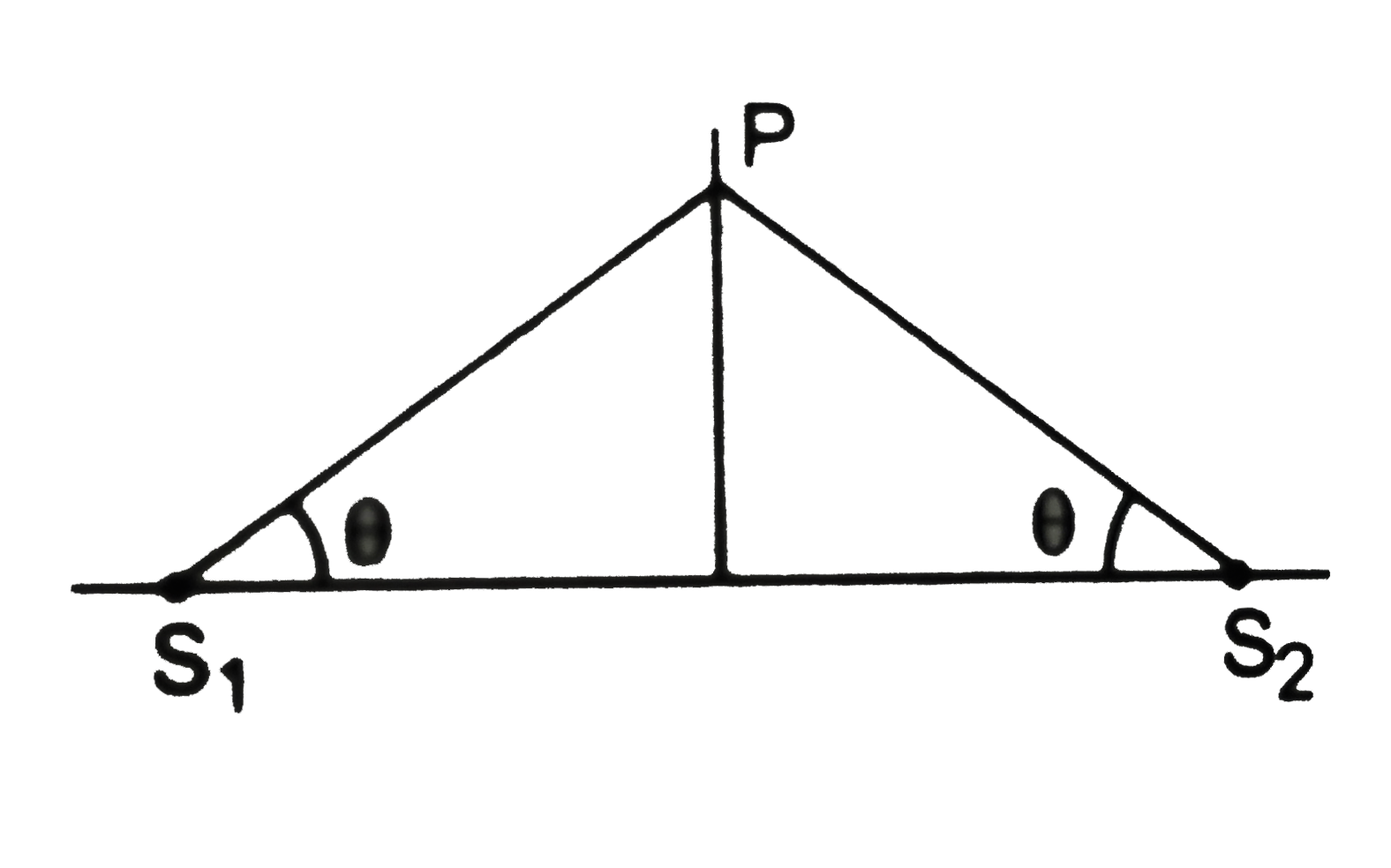
View SolutionFind the fundamental, first overtone and second overtone frequencies of an open organ pipe of length 20 cm. Speed of sound in air is `340 m s^-1`.
View SolutionA closed organ pipe can vibrate at a minimum frequency of 500 Hz. Find the length of the tube. Speed of sound in air `= 340 m s^-1`.
View SolutionIn a standing wave pattern in a vibrating air column, nodes are formed at a distance of 4.0 cm. If the speed of sound in air is` 328 ms^-1` what is the frequency of the source ?
View SolutionThe separation between a node and the next antinode in a vibrating air column is 25 cm. If the speed of sound in air is `340 m s^-1`, find the frequency of vibration of the air column.
View SolutionA cylindrical metal tube has a length of 50 cm and is open at both ends. Find the frequencies between 1000 Hz and 2000 Hz at which the air column in the tube can resonate. Speed of sound in air is `340 m s^-1`.
View SolutionIn a resonance column experiment, a tuning fork of frequency 400 Hz is used. The first resonance is observed when the air column has a length of 20.0 cm and the second resonance is observed when the air column has a length of 62.0 cm. (a) Find the speed of sound in air.(b) How much distance above the open end does the pressure node form ?
View SolutionThe first overtone frequency of a closed organ pipe `P_1` is equal to the fundamental frequency of an open organ pipe `P_2`. If the length of the pipe `P_1` is 30 cm, what will be the length of` P_2`?
View SolutionA copper rod of length 1.0 m is clamped at its middle point. Find the frequencies between 20 Hz and 20,000 Hz at which standing longitudinal waves can be set up in the rod. The speed of sound in copper is `3.8 km s^-1`.
View SolutionFind the greatest length of an organ pipe open at both ends that will have its fundamental frequency in the normal hearing range (20-20,000 Hz). Speed of sound in air `= 340 ms^-1`.
View SolutionAn open organ pipe has a length of 5 cm. (a) Find the fundamental frequency of vibration of this pipe. (b) What is the highest harmonic of such a tube that is in the audible range ? Speed of sound in air is `340 ms^-1` and the audible range is 20-20,000 Hz.
View SolutionAn electronically driven loudspeaker is placed near the open end of a resonance column apparatus. The length of air column in the tube is 80 cm. The frequency of the loudspeaker can be varied between 20 Hz and 2 kHz. Find the frequencies at which the column will resonate. Speed of sound in air `= 320 m s^-1`
View SolutionTwo successive resonance frequencies in an open organ pipe are 1944 Hz and 2592 Hz. Find the length of the tube. The speed of sound in air is `324 m s^-1`.
View SolutionA piston is fitted in a cylindrical tube of small cross section with the other end of the tube open. The tube resonates with a tuning fork of frequency 512 Hz. The piston is gradually pulled out of the tube and it is found that a second resonance occurs when the piston is pulled out through a distance of 32.0 cm. Calculate the speed of sound in the air of the tube.
View SolutionA U-tube having unequal arm-lengths has water in it. A tuning fork of frequency 440 Hz can set up the air in the shorter arm in its fundamental mode of vibration and the same tuning fork can set up the air in the longer arm in its first overtone vibration. Find the length of the air columns Neglect any end effect and assume that the speed of sound in air `= 330 ms^-1`
View SolutionConsider the situation shown in figure. The wire which has a mass of 4.00 g oscillates in its second harmonic and sets the air column in the tube into vibrations in its fundamental mode. Assuming that the speed of sound in air is `40 m s^-1`, find the tension in the wire.
 .
.
View SolutionA 30.0-cm-long wire having a mass of 10.0 g is fixed at the two ends and is vibrated in its fundamental mode.A 50.0-cm-long closed organ pipe, placed with its open end near the wire, is set up into resonance in its fundamental mode by the vibrating wire. Find the tension in the wire. Speed of sound in air `= 340 m s^-1`.
View SolutionShow that if the room temperature changes by a small amount from `T to T +/_\T`, the fundamental frequency of an organ pipe changes from `v to v + /_\v, where
`(/_\v)/v=1/2(/_\T)/T`.
View SolutionThe fundamental frequency of a closed pipe is 293 Hz when the air in it is at a temperature of `20^@C`. What will be its fundamental frequency when the temperature changes to `22^@C` ?
View SolutionA Kundt's tube apparatus has a copper rod of length 1.0 m clamped at 25 cm from one of the ends. The tube contains air in which the speed of sound is `340 ms^-1` The powder collects in. heaps separated by a distance of 5.0 cm. Find the speed of sound waves in copper.
View SolutionA Kundt's tube apparatus has a steel rod of length 1.0 m 66. clamped at the centre. It is vibrated in its fundamental mode at a frequency of 2600 Hz. The lycopodium powder dispersed in the tube collects into heaps separated by 6.5 cm. Calculate the speed of sound in steel and in air.
View SolutionA source of sound with adjustable frequency produces 2. beats per second with a tuning fork when its frequency is either 476 Hz or 480 Hz. What is the frequency of the tuning fork ?
View SolutionA tuning fork produces 4 beats per second with another 68. tuning fork of frequency 256 Hz. The first one is now loaded with a little wax and the beat frequency is found to increase to 6 per second. What was the original frequency of the tuning fork ?
View SolutionCalculate the frequency of beats produced in air when two sources of sound are activated, one emitting a wavelength of 32 cm and the other of 32.2 cm. The speed of sound in air is `350 ms^-1`.
View SolutionA tuning fork of unknown frequency makes 5 beats per second with another tuning fork which can cause a closed organ pipe of length 40 cm to vibrate in its fundamental mode. The beat frequency decreases when the first tuning fork is slightly loaded with wax. Find its original frequency. The speed of sound in air is `320 ms^-1`
View SolutionA piano wire A vibrates at a fundamental frequency of 600 Hz. A second identical wire B produces 6 beats per second with it when the tension in A is slightly increased. Find the ratio of the tension in A to the tension in B.
View SolutionA tunnig fork of frequency 256 Hz produces 4 beats per second with a wire of length 25 cm vibrating in its fundamental mode. The beat frequency decreases when the length is slightly shortened. What could be the minimum length by which the wire be shortened so that it produces no beats with the tuning fork ?
View SolutionA traffic policeman standing on a road sounds a whistle emitting the main frequency of 2.00 kHz. What could be the apparent frequency heard by a scooter driver approaching the policeman at a speed of `36.0km h^(-1) ?` Speed of sound in air `=340 m s^(-1).`
View SolutionThe horn of a car emits sound with a dominant frequency of 2400 Hz. What will be the apparent dominant frequency heard by a person standing on the road in front of the car if the car is approaching at `18.0 km h^-1`? Speed of sound in air` = 340 m s^-1`
View SolutionA person riding a car moving at `72 km h^-1` sounds a whistle emitting a wave of frequency 1250 Hz. What frequency will be heard by another person standing on the road (a) in front of the car (b) behind the car ? Speed of sound in air `= 340 m s^-1` .
View SolutionA train approaching a platform at a speed of `54 km h^-1` sounds a whistle. An observer on the platform finds its frequency to be 1620 Hz. The train passes the platform keeping the whistle on and without slowing down. What frequency will the observer hear after the train has crossed the platfrom ? The speed of sound in air `= 332 ms^-1`
View SolutionA bat emitting an ultrasonic wave of frequecy `4.5 xx 10^4` Hz flies at a speed of `6ms^(-1)` between two parallel walls. Find the two frequecies heard by the bat and the beat frequecy between the two. The speed of sound is `330ms^(-1)`
View SolutionA bullet passes past a person at a speed of `220 m s^-1`. Find the fractional change in the frequency of the whistling sound heard by the person as the bullet crosses the person. Speed of sound in air `= 330 m s^-1`.
View SolutionTwo electric trains run at the same speed of `72 km h^-1` along the same track and in the same direction with a separation of 2.4 kin between them. The two trains simultaneously sound brief whistles. A person is situated at a perpendicular distance of 500 m from the track and is equidistant from the two trains at the instant of the whistling. If both the whistles were at 500 Hz and the speed of sound in air is `340 m s^-1`, find the frequencies heard by the person.
View SolutionA violin player riding on a slow train plays a 440 Hz note. Another violin player standing near the track plays the same note. When the two are close by and the train approaches the person on the ground, he hears 4'0 beats per second. The speed of sound in air` = 340 ms^-1` (a) Calculate the speed of the train. (b) What beat frequency is heard by the player in the train ?
View SolutionTwo identical tuning forks vibrating at the same frequency 256 Hz are kept fixed at some distance apart. A listener runs between the forks at a speed of `3.0 m s^-1` so that he approaches one tuning-fork and recedes from the other. find the beat frequency bserved by the listener. Speed of sound in air `= 332 m s^-1`.
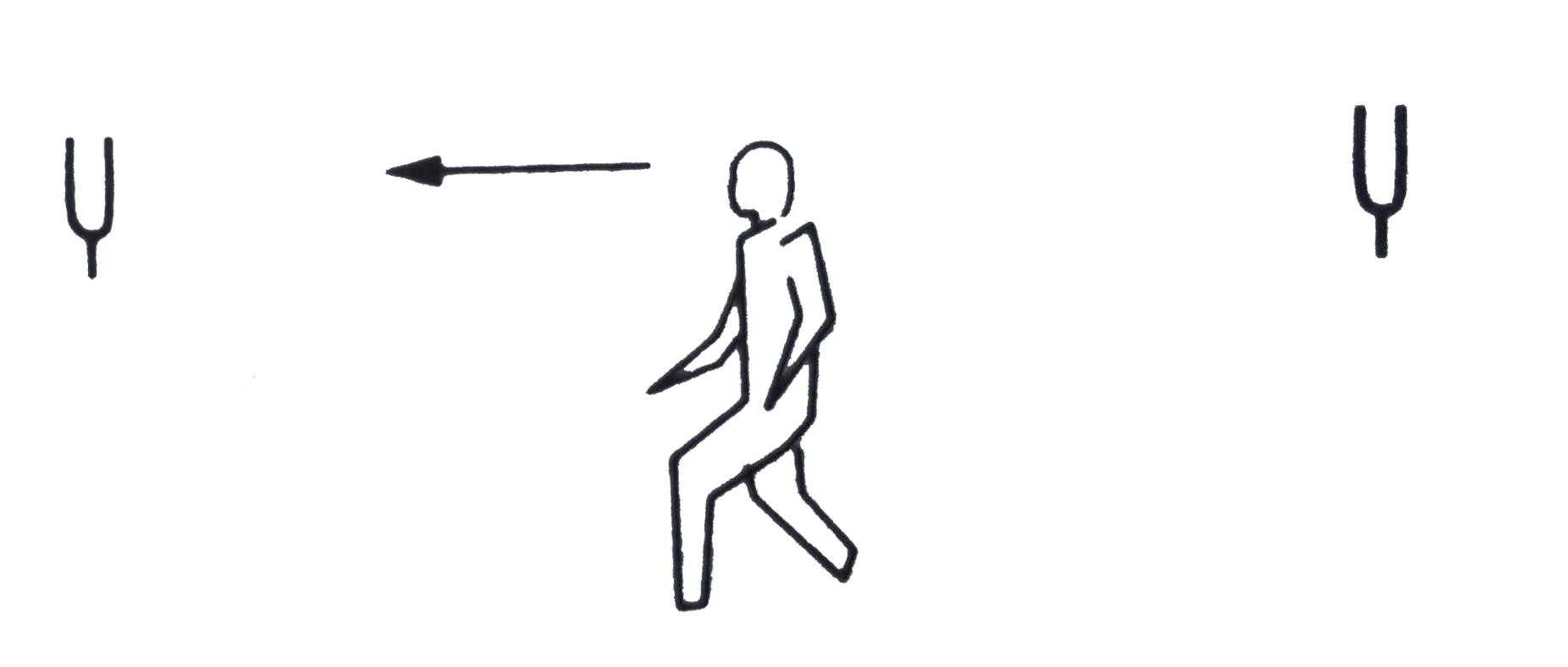 .
.
View SolutionFigure shows a person standing somewhere in between two identical tunning forks, each vibrating at `512 Hz. If both the tuning forks move towards right at a speed of `5.5 ms^-1`, find the number of beats heard by the listener. Speed of sound in air `=330 ms^-1`.

View SolutionA small source of sound vibrating at frequency 500 Hz is rotated in a circle of radius `100/2pi` cm at a constant angular speed of 5-0 revolutions per second. A listener situates himself in the plane of the circle. Find the minimum and the maximum frequency of the sound observed. Speed of sound in air `= 332 m s^-1`.
View SolutionTwo trains are travelling towards each other both at a speed of `90 km h^-1`. If one of the trains sounds a whistle at 500 Hz, what will be the apparent frequency heard in the other train ? Speed of sound in air `= 350 m s^-1.
View SolutionA traffic policeman sounds a whistle to stop a car-driver approaching towards him. The car-driver does not stop and takes the plea in court that because of the Doppler shift, the frequency of the whistle reaching him might have gone beyond the audible limit of 20 kHz and he did not hear it. Experiments showed that the whistle emits a sound with frequency close to 16 kHz. Assuming that the claim of the driver is true, how fast was he driving the car ? Take the speed of sound in air to be `330 m s^-1`. Is this speed practical with today's technology ?
View SolutionA car moving at `108 km h^-1` finds another car in front of it going in the same direction at `72 km h^-1`. The first car sounds a horn that has a dominant frequency of 800 Hz. What will be the apparent frequency heard by the driver in the front car ? Speed of sound in air ` = 330 ms^-1`
View SolutionTwo submarines are approaching each other in a calm sea. The first submarine travels at a speed of `36 km h^-1` and the other at `54 km h^-1` relative to the water. The first submarine sends a sound signal (sound waves in water are also called sonar) at a frequency of 2000 Hz. (a) At what frequency is this signal received by the second submarine ? (b) The signal is reflected from the second submarine. At what frequency is this signal received by the first submarine. Take the speed of the sound wave in water to be `1500 m s^-1` .
View SolutionA small source of sound oscillates in simple harmonic motion with an amplitude of 17 cm. A detector is placed along the line of motion of the source. The source emits a sound of frequency 800 Hz which travels at a speed of `340 ms^-1` If the width of the frequency band detected by the detector is 8 Hz, find the time period of the source.
View SolutionA boy riding on his bike is going towards east at a speed of `4sqrt2ms^-1`. At a certain point he produces a sound pulse of frequency 1650 Hz that travels in air at a speed of `334 m s^-1` . A second boy stands on the ground `45^@` south of east from him. Find the frequency of the pulse as received by the second boy.
View SolutionA sound source, fixed at the origin, is continuously emitting sound at a frequency of 660 Hz. The sound travels in air at a speed of `330 ms^-1`. A listener is moving along the line x = 336 m at a constant speed of 26 m Find the frequency of the sound as observed by the listener when he is a. at `y=-140m, b. at y=0 and c. at y=140m`.
View SolutionA train running at `108 km h^-1 towards east whistles at a dominant frequency of 500 Hz. Speed of sound in air is 340 m/s. What frequency will a passenger sitting near the open window hear ? (b) What frequency will a person standing near the track hear whom the train has just passed ? (c) A wind starts blowing towards east at a speed of 36 km h-1. Calculate the frequencies heard by the passenger in the train and by the person standing near the track.
View SolutionA boy riding on a bicycle going at `12 km h^-1` towards a vertical wall whistles at his dog on the ground. If the frequency of the whistle is 1600 Hz and the speed of sound in air is `330 m s^-1, find (a) the frequency of the whistle as received by the wall (b) the frequency of the reflected whistle as received by the boy.
View SolutionA person standing on a road sends a sound signal to the driver of a car going away from him at a speed of `72 km h^-1. The signal travelling at `330 m s^-1 in air and having a frequency of 1600 Hz gets reflected from the body of the car and returns. Find the frequency of the reflected signal as heard by the person.
View SolutionA car moves with a speed of `54 kmh^-1` towards a cliff. The horn of the car emits sound of frequency 400 Hz at a speed of `335 m s^-1`. (a) Find the wavelength of the sound emitted by the horn in front of the car. (b) Find the wavelength of the wave reflected from the cliff (c) What frequency does a person sitting in the car hear for the reflected sound wave ? (d) How many beats does he hear in 10 seconds between the sound coming directly from the horn and that coming after the reflection ?
View SolutionAn operator sitting in his base camp sends a sound signal of frequency 400 Hz. The signal is reflected back from a car moving towards him The frequency of the reflected sound is found to be 410 Hz. Find the speed of the car. Speed of sound in air` = 324 m s^-1`.
View SolutionFigure shows a source of sound moving along the X-axis at a speed of `22 m s^-1` continuously emitting a sound of frequency 2.0 kHz which travels in air at a speed of `330 in s^-1`. A listener Q stands on the Y-axis at a distance of 330 m from the origin. At t = 0, the source crosses the origin P. (a) When does the sound emitted from the source at P reach the listener Q 9 (b) What will be the frequency heard by the listener at. this instant 9 (c) Where will the source be at this instant ?
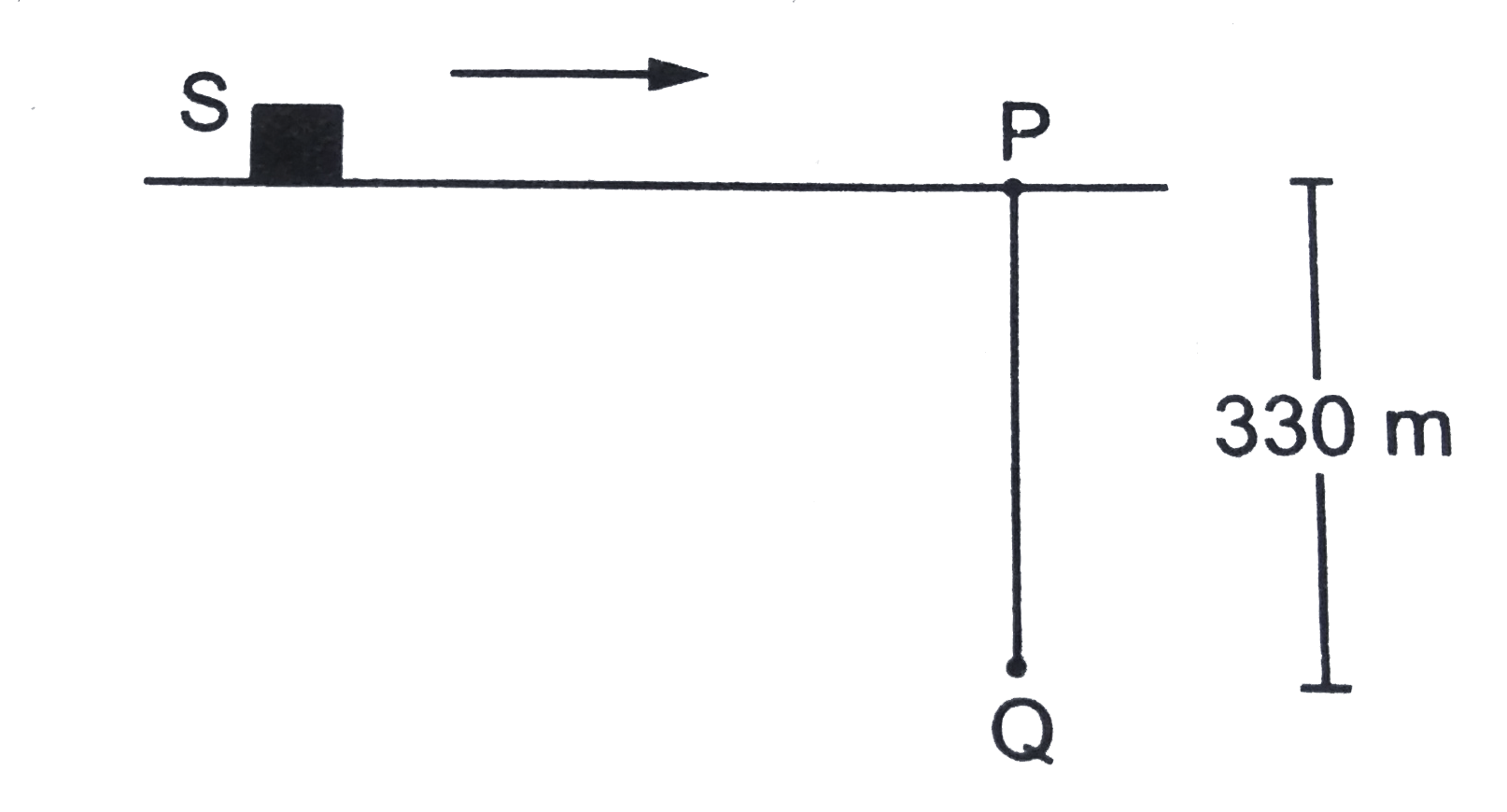 .
.
View SolutionA source emitting sound at frequency 4000 Hz, is moving along the Y-axis with a speed of `22 m s^-1`. A listener is situated on the ground at the position (660 m, 0). Find the frequency of the sound received by the listener at the instant the source crosses the origin. Speed of sound in air` = 330 m s^-1`.
View SolutionA source of sound emitting a 1200 Hz note travels along a straight line at a speed of `170 m s^-1`. A detector is placed at a distance of 200 m from the line of motion of the source. (a) Find the frequency of sound received by the detector at the instant when the source gets closest to it. (b) Find the distance between the source and the detector at the instant it detects the frequency 1200 Hz. Velocity of sound in air` = 340 m s^-1`.
View SolutionA small source of sound S of frequency 500 Hz is attached to the end of a light string and is whirled in a vertical circle of radius 1.6 in. The string just remains tight when the source is at the highest point. (a) An observer is located in the same vertical plane at a large distance and at the same height as the centre of the circle. The speed of sound in air `= 330 m s^-1 and `g = 10ms^-2`. Find the maximum frequency heard by the observer. (b) An observer is situated at a large distance vertically above the centre of the circle. Find the frequencies heard by the observer corresponding to the sound emitted by the source When it is at the same height as the centre. ltbr.

View SolutionA source emitting a sound of frequency v is placed at a large distance from an observer. The source starts moving towards the observer with a uniform acceleration a. Find the frequency heard by the observer corresponding to the wave emitted just after the source starts. The speed of sound in the medium is v.
View Solution
Exercises questions and complete solutions for chapter SOUND WAVES of HC VERMA PHYSICS (HINGLISH) of Class 11